电子科技大学:《语言学通论 General Linguistics》课程教学资源(课件讲稿)语义学——Componential Analysis
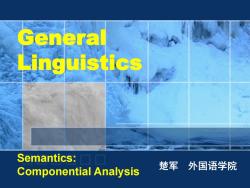
General Linguistics Semantics: 楚军 外国语学院 Componential Analysis
Semantics: Componential Analysis 楚军 外国语学院 General Linguistics
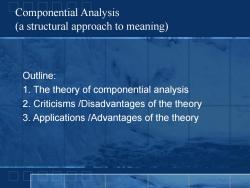
Componential Analysis (a structural approach to meaning) Outline; 1.The theory of componential analysis 2.Criticisms /Disadvantages of the theory 3.Applications /Advantages of the theory
Componential Analysis (a structural approach to meaning) Outline: 1. The theory of componential analysis 2. Criticisms /Disadvantages of the theory 3. Applications /Advantages of the theory
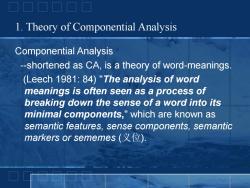
1.Theory of Componential Analysis Componential Analysis --shortened as CA,is a theory of word-meanings. (Leech 1981:84)"The analysis of word meanings is often seen as a process of breaking down the sense of a word into its minimal components,"which are known as semantic features,sense components,semantic markers or sememes(义位)
1. Theory of Componential Analysis Componential Analysis --shortened as CA, is a theory of word-meanings. (Leech 1981: 84) "The analysis of word meanings is often seen as a process of breaking down the sense of a word into its minimal components, " which are known as semantic features, sense components, semantic markers or sememes (义位)
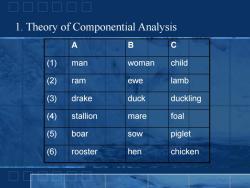
1.Theory of Componential Analysis A B (1) man woman child (2) ram ewe lamb (3) drake duck duckling (4) stallion mare foal (5) boar SOW piglet (6) rooster hen chicken
1. Theory of Componential Analysis A B C (1) man woman child (2) ram ewe lamb (3) drake duck duckling (4) stallion mare foal (5) boar sow piglet (6) rooster hen chicken
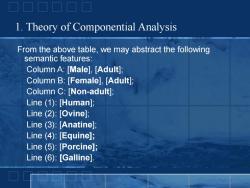
1.Theory of Componential Analysis From the above table,we may abstract the following semantic features: Column A:[Male],[Adult]; Column B:[Female],[Adult]; Column C:[Non-adult]; Line (1):[Human]; Line (2):[Ovine]; Line (3):[Anatine]; Line (4):[Equine]; Line (5):[Porcine]; Line (6):[Galline]
From the above table, we may abstract the following semantic features: Column A: [Male], [Adult]; Column B: [Female], [Adult]; Column C: [Non-adult]; Line (1): [Human]; Line (2): [Ovine]; Line (3): [Anatine]; Line (4): [Equine]; Line (5): [Porcine]; Line (6): [Galline]. 1. Theory of Componential Analysis
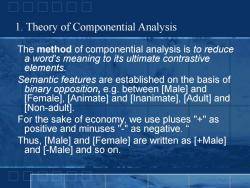
1.Theory of Componential Analysis The method of componential analysis is to reduce a word's meaning to its ultimate contrastive elements. Semantic features are established on the basis of binary opposition,e.g.between [Male]and [Female],[Animate]and [Inanimate],[Adult]and [Non-adult]. For the sake of economy,we use pluses "+as positive and minuses "_as negative. Thus,[Male]and [Female]are written as [+Male] and [-Male]and so on
The method of componential analysis is to reduce a word's meaning to its ultimate contrastive elements. Semantic features are established on the basis of binary opposition, e.g. between [Male] and [Female], [Animate] and [Inanimate], [Adult] and [Non-adult]. For the sake of economy, we use pluses "+" as positive and minuses "-" as negative. “ Thus, [Male] and [Female] are written as [+Male] and [-Male] and so on. 1. Theory of Componential Analysis
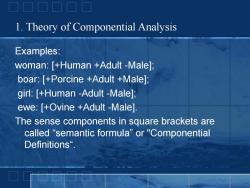
1.Theory of Componential Analysis Examples: woman:[+Human +Adult -Male]; boar:[+Porcine +Adult +Male]; girl:[+Human -Adult -Male]; ewe:[+Ovine +Adult -Male]. The sense components in square brackets are called“semantic formula”or"Componential Definitions
Examples: woman: [+Human +Adult -Male]; boar: [+Porcine +Adult +Male]; girl: [+Human -Adult -Male]; ewe: [+Ovine +Adult -Male]. The sense components in square brackets are called “semantic formula” or "Componential Definitions“. 1. Theory of Componential Analysis
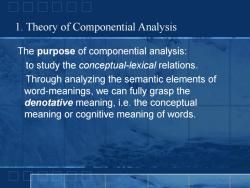
1.Theory of Componential Analysis The purpose of componential analysis: to study the conceptual-lexical relations. Through analyzing the semantic elements of word-meanings,we can fully grasp the denotative meaning,i.e.the conceptual meaning or cognitive meaning of words
The purpose of componential analysis: to study the conceptual-lexical relations. Through analyzing the semantic elements of word-meanings, we can fully grasp the denotative meaning, i.e. the conceptual meaning or cognitive meaning of words. 1. Theory of Componential Analysis
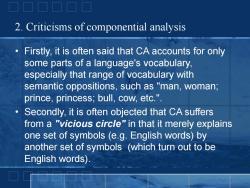
2.Criticisms of componential analysis Firstly,it is often said that CA accounts for only some parts of a language's vocabulary, especially that range of vocabulary with semantic oppositions,such as "man,woman; prince,princess;bull,cow,etc.". Secondly,it is often objected that CA suffers from a "vicious circle"in that it merely explains one set of symbols (e.g.English words)by another set of symbols (which turn out to be English words)
2. Criticisms of componential analysis • Firstly, it is often said that CA accounts for only some parts of a language's vocabulary, especially that range of vocabulary with semantic oppositions, such as "man, woman; prince, princess; bull, cow, etc.". • Secondly, it is often objected that CA suffers from a "vicious circle" in that it merely explains one set of symbols (e.g. English words) by another set of symbols (which turn out to be English words)
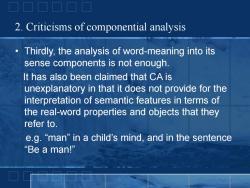
2.Criticisms of componential analysis Thirdly,the analysis of word-meaning into its sense components is not enough. It has also been claimed that CA is unexplanatory in that it does not provide for the interpretation of semantic features in terms of the real-word properties and objects that they refer to. e.g."man"in a child's mind,and in the sentence “Be a man!
• Thirdly, the analysis of word-meaning into its sense components is not enough. It has also been claimed that CA is unexplanatory in that it does not provide for the interpretation of semantic features in terms of the real-word properties and objects that they refer to. e.g. “man” in a child’s mind, and in the sentence “Be a man!” 2. Criticisms of componential analysis
按次数下载不扣除下载券;
注册用户24小时内重复下载只扣除一次;
顺序:VIP每日次数-->可用次数-->下载券;
- 电子科技大学:《语言学通论 General Linguistics》课程教学资源(课件讲稿)语义学——Context, changes in word meaning, figures of speech.pdf
- 电子科技大学:《语言学通论 General Linguistics》课程教学资源(课件讲稿)语义学——Semantics(Sense Relations).pdf
- 电子科技大学:《语言学通论 General Linguistics》课程教学资源(课件讲稿)语义学——Types of word-meaning.pdf
- 电子科技大学:《语言学通论 General Linguistics》课程教学资源(课件讲稿)07 Semantics(Introduction).pdf
- 电子科技大学:《语言学通论 General Linguistics》课程教学资源(课件讲稿)06 Functional Grammar.pdf
- 电子科技大学:《语言学通论 General Linguistics》课程教学资源(课件讲稿)05 句法 Syntax.pdf
- 电子科技大学:《语言学通论 General Linguistics》课程教学资源(课件讲稿)04 Formalist Approach.pdf
- 电子科技大学:《语言学通论 General Linguistics》课程教学资源(课件讲稿)03 Formalist Approach.pdf
- 电子科技大学:《语言学通论 General Linguistics》课程教学资源(课件讲稿)02 句法 Syntax.pdf
- 电子科技大学:《语言学通论 General Linguistics》课程教学资源(课件讲稿)01 Introduction(主讲:楚军).pdf
- 山东省“成人教育特色课程”项目配套教材:《大学语文》课程教材电子版(主编:戴永新).pdf
- 聊城大学:《大学语文》课程教学资源(阅读文献)中国现当代文学经典作品选.pdf
- 聊城大学:《大学语文》课程教学资源(阅读文献)外国文学经典作品选.pdf
- 聊城大学:《大学语文》课程教学资源(阅读文献)中国古代文学经典作品选.pdf
- 聊城大学:《大学语文》课程教学资源(电子教案讲义,共十五讲).docx
- 运城学院:《文学概论 literature theory》课程教学资源(电子教案,打印版,2/2,共两编八章).pdf
- 运城学院:《文学概论 literature theory》课程教学资源(电子教案,打印版,1/2,共三篇八章).pdf
- 运城学院:《文学概论 literature theory》课程教学资源(教学大纲,打印版).pdf
- 运城学院:《秘书写作 Daily practical Writing》课程PPT教学课件(事务文书写作)15.总结述职报告.ppt
- 运城学院:《秘书写作 Daily practical Writing》课程PPT教学课件(事务文书写作)14.讣告悼词.ppt
- 电子科技大学:《语言学通论 General Linguistics》课程教学资源(课件讲稿)语义学——Sentence meaning(Predication Analysis).pdf
- 电子科技大学:《语言学通论 General Linguistics》课程教学资源(课件讲稿)10 Langugae, culture & society.pdf
- 电子科技大学:《语言学通论 General Linguistics》课程教学资源(课件讲稿)09 Pragmatics(Utterance Meaning).pdf
- 电子科技大学:《语言学通论 General Linguistics》课程教学资源(课件讲稿)形态学 Morphology.pdf
- 电子科技大学:《语言学通论 General Linguistics》课程教学资源(课件讲稿)认知语言学中的相关话题 Cognitive Linguistics.pdf
- 弟子规(全文).pdf
- 《中国语言文化 Chinese Language and Culture》课程教学资源(书籍阅读材料)《中国古典哲学名著选读》郭齐勇.pdf
- 《中国语言文化 Chinese Language and Culture》课程教学资源(书籍阅读材料)《唐诗三百首》中英文对照(许渊冲)300 Tang Poems(Classified by Theme).pdf
- 《中国语言文化 Chinese Language and Culture》课程教学资源(书籍阅读材料)《二十四诗品校注译评》祖保泉.pdf
- 《中国语言文化 Chinese Language and Culture》课程教学资源(书籍阅读材料)《近代中国之种族观念》刘东.pdf
- 《中国语言文化 Chinese Language and Culture》课程教学资源(书籍阅读材料)《中国现代女作家与中国革命1905-1948》颜海平.pdf
- 《中国语言文化 Chinese Language and Culture》课程教学资源(书籍阅读材料)《世界秩序与文明等级》全球史研究的新路径(主编:刘禾).pdf
- 《中国语言文化 Chinese Language and Culture》课程教学资源(书籍阅读材料)《叫魂》SOULSTEALERS - The Chinese Sorcery Scare of 1768〔美〕孔飞力(1768年中国妖术大恐慌).pdf
- 电子科技大学:《中国语言文化 Chinese Language and Culture》课程教学资源(课件讲稿)导论(聂韬).pdf
- 电子科技大学:《中国语言文化 Chinese Language and Culture》课程教学资源(课件讲稿)第一讲 周易.pdf
- 电子科技大学:《中国语言文化 Chinese Language and Culture》课程教学资源(课件讲稿)第七讲 谶纬之学.pdf
- 电子科技大学:《中国语言文化 Chinese Language and Culture》课程教学资源(课件讲稿)第三讲 山海经.pdf
- 电子科技大学:《中国语言文化 Chinese Language and Culture》课程教学资源(课件讲稿)第二讲 尚书.pdf
- 电子科技大学:《中国语言文化 Chinese Language and Culture》课程教学资源(课件讲稿)第五讲 道家与魏晋风度.pdf
- 电子科技大学:《中国语言文化 Chinese Language and Culture》课程教学资源(课件讲稿)第八讲 诗歌的创作翻译与批评之平仄格律.pdf
